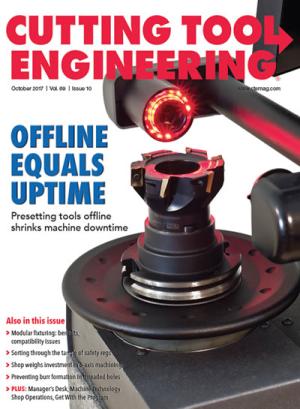Although I imagine that some workaholics find taking short breaks frightening, the above headline refers to 5-axis machining, which is one of this issue’s focuses.
In addition to Christopher Tate’s article on page 72 about how investing in a 5-axis machine can pay significant dividends, the Machine Technology column on page 30 is about measuring 5-axis centerlines. The latter is authored by guest columnist Michael Cope, product technical specialist for Indianapolis-based Hurco Cos. Inc.
Coincidentally, Cope just published a book about 5-axis machining titled The Power of Five: The Definitive Guide to 5-Axis Machining, which is available from Lulu Press Inc. (tinyurl.com/y9ganrn3). When considering whether to integrate 5-axis machining, keep in mind that it isn’t only for producing complex parts, such as blisks and impellers for the aerospace industry, via simultaneous 5-axis movements.
In his book, Cope states that the vast majority of work that is driving parts manufacturers to buy 5-axis machines is for five-sided, or 3+2, machining. This positional 5-axis machining enables shops to cut relatively simple geometries on multiple sides of the same part, which can provide a significant competitive advantage by improving part accuracy and throughput. Conversely, a 3-axis approach requires individual, time-consuming setups for each side of the part.
Along with clearly and concisely presented information, Cope’s book is packed with photos and illustrations that complement the copy. The photos do show some of Hurco’s 5-axis machines, but, as was his intention, the information is neutral and nonpromotional.
Another big proponent of 5-axis machining is Titan Gilroy, CEO of the machine shop Titan America MFG, Rocklin, Calif., and executive producer/star of the “Titans of CNC” cable TV show.
“Five-axis is absolutely changing the game,” he said. “It’s nothing to be scared of; software does it all for you. Now you are able to take five different sides, nine different sides, 11 different sides and do them all in one setup, which alleviates a lot of long programming.”
According to Gilroy, one important software function that simplifies 5-axis machining is dynamic offsetting. “So instead of flipping something around and having a million different offsets, you have dynamic, which is one offset.”
He added that a 5-axis machine typically costs more than a 3-axis one, but the payback is quick. “It just saves a huge amount of time.”
In addition to the 5-axis machines at his shop, Gilroy established a machining program at California’s San Quentin State Prison and helped equip the shop with 18 5-axis machines as part of the shop remodeling effort. According to Gilroy, who served hard time for assault before beginning his machining career, San Quentin offers an elite manufacturing facility. “They make the most difficult parts imaginable,” he said.
Although some might feel that remodeling a maximum-security prison poses an unnecessary danger—Gilroy said his insurance company dropped him due to the risk of working in prison—he emphasized that he was the most protected person there because he gave prisoners hope.


